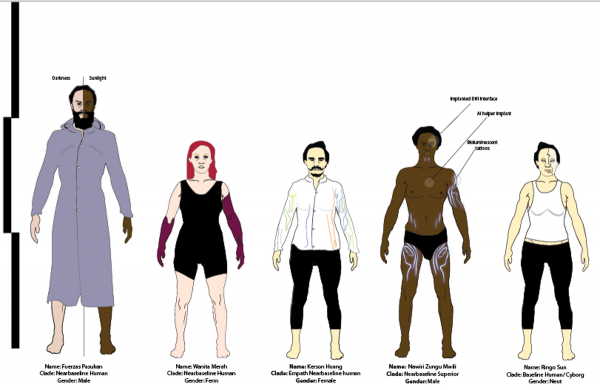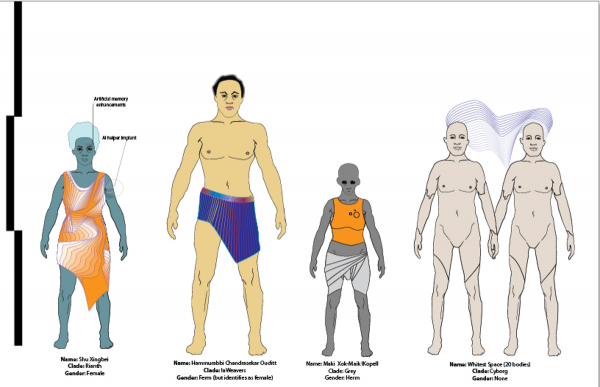BY LETTER
Nearbaseline Human Genemods
Technology > Technology Type or Material > Gengineering
Sophonts > Modosophonts > Near-Baseline Human
Sophonts > Modosophonts > Near-Baseline Human
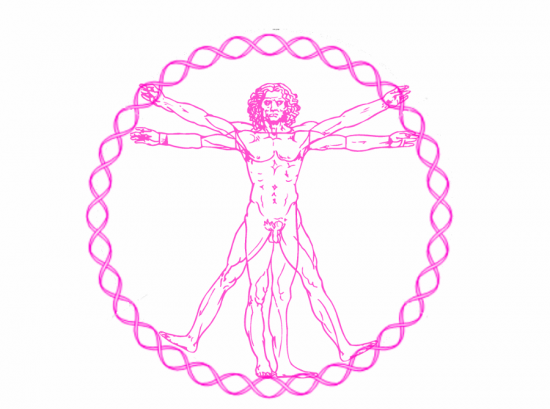 Image from Steve Bowers |
Of all the Terragen clades and superclades the human nearbaselines have perhaps changed the least from their original Old Earth progenitors. Although there is huge diversity among nebs a typical clade member is superficially similar to a baseline human of Old Earth; albeit healthier and more capable at mental and physical tasks than the average. Cosmetically there is great variety with different populations exploring different standards of beauty available to the human form. Consequently despite being objectively better in many ways than their baseline cousins nearbaselines would be as likely to appear disturbing as attractive to an ancient baseline of the homeworld.
Unlike their Homo superior cousins the nearbaseline superclade lacks any real central or major movement to define the genetic template. Instead personal choice and fashionable experimentation have driven the adoption of genemods in random and eclectic ways. Few nearbaseline populations (or indeed individuals) possess the same set of modifications. Owing to this nebs are rarely interfertile with baselines or with other neb clades, more often than not this is exacerbated by design to avoid giving rise to offspring with disorders caused by incompatible gengineering. Two reproductive strategies have developed to deal with this; first the use of medical software to compile healthy genomes for offspring by editing two (or more) parental genomes and second ensuring most modifications are to the somatic genotype leaving the germline with a safe core of mods. Some neb clades even maintain purely baseline germline genomes, giving rise to children that can choose their own modifications as they develop.
For all of that there have been some common trends in human nearbaseline development. The following are some of the general categories of genetic traits that have become common in nearbaseline populations in the last ten millennia. The traits listed below range from moderately common to nearly ubiquitous, but none is universal. Nearbaseline diversity is tremendous, greater by far than that of the original species.
Genome organisation mods
Arguably the most fundamental changes between baseline and nearbaseline genomes has been at the level of basic organisation. Instead of radical modification on an individual basis, nearbaselines have increased the health of communities as well as facilitating the process of further gengineering by populations and individuals alike.Modular genetics: The genomes of nebs have been iteratively redesigned over millennia to make them easier to modify in a number of ways. Most important has been the bracketing of every gene, promoter and significant genomic region with a unique restriction site as well as a complex cellular tagging system that results in every cell expressing detailed markers on its surface based on type, function and location in the body. These changes allow nearbaselines to modify their somatic genotype much more easily than baselines; simple liposomes coated in the appropriate cell tags can carry specialised enzymes to edit the genome as needed. Long segments can be inserted that cause a programmed series of cellular behaviours that, in accordance with signals from neighbouring cells following their own programs, leads to large scale tissue remodelling. This system makes radical macroscopic changes possible even after critical windows of development have passed. Once complete signalling pathways expressed by the long segments result in their excision. Even in an era wherein symbiotic molecular machines inhabit every cell modular systems have been retained as they facilitate any genetic tinkering undertaken by the medisystem. Regardless of method all modular genome approaches include a sufficient degree of redundancy such that, in event of mutation across generations, easy gengineering is retained. Beneficially this makes fixing any mutation a simple process. However without suitable monitoring issues can arise over many generations and neb groups wishing to adopt a long term ludd lifestyle should look to making their genome more robust.
Deleterious gene removal: Often a controversial set of mods as the definition of unfavorable traits is, in part, cultural. Early in the development of the nearbaseline population hereditary traits such as Tay-Sachs disease, colour blindness, albinism, hemophilia, nearsightedness and gigantism were eliminated with little debate. Others, which had provided resistance to certain diseases when inherited as a single allele (i.e. sickle cell anemia, cystic fibrosis and thalassemia), were soon to follow once the diseases themselves were no longer a factor. The elimination of most starvation-resistance genes from the nearbaseline population (owing to the side effect of obesity in nutrient rich modern society) was also conducted with little opposition. Genes for most forms of dwarfism have left the nearbaseline population, but not without the secession of some groups who chose to form separate clades instead. More controversial were attempts to remove the genetic basis of such traits as Attention Deficit Disorder, schizophrenia, autism, and a host of other mental traits. Many of these proved to be part of conditions that are favourable to the individual under the correct environmental, prenatal and early childhood conditions. Furthermore many came to be considered a natural feature of the toposophic variability that helps keep a human nearbaseline society healthy. Due to this, some populations have retained many of these "defects."
Mental and Emotional Mods
In many cases these have been copied from successful models in clades outside the nearbaseline gene pool or are the result of admixture with more distinctive clades. Many nearbaseline traits in this area are actually the result of an enriched childhood environment, highly advanced teaching techniques, access to extensive data and other factors. These alone produce levels of performance that an Old Earth human would have found astounding, but nearbaselines have the additional advantage of genetic aptitudes in these areas.Biofeedback trance: Many nearbaseline genemods grant some level of conscious control over physical and mental states that are otherwise autonomous. The exact method of control varies but initially most mods relied on some easy to acquire external agent (such as a specific ingestible chemical) or the introduction of a gland activated through delicate contraction of the surrounding muscles. Development of control systems largely ceased after the Technocalypse, with the spread of safe neural implants that could provide an easy interface between mind and body. Despite this gengeneering enthusiasts continued to work on more "natural" methods. Schools within the Biopolity introduced the most widespread and popular method that persists to this day; a series of specific neural pathways that, when activated, induce a light trance-like state from which a neb can psychosomatically interact with the relevant mods. To enter the trance a neb initiates some form of patterned physical activity such as breathing, humming or tapping (different mods allow for different activities). The circuits become sensitised and stimulate an auditory hallucination of tones; if the neb then matches the rhythm of their activity to the tones the circuits activate fully drawing the neb into the trance. Whilst in this state they are still aware of their surroundings but are primarily focused on artificial sensations within their body. These sensations represent the various modified processes that can be consciously altered. Attempting to manipulate these areas in a manner similar to muscle contraction and relaxation causes the release of signalling molecules that enact the desired changes. The trance is easily left at any time by shifting one's attention. Neb children with this type of modification require training to learn to use it properly. Even among clades that choose to use exoself technology rather than trance based methods to control their internal status, the Biopolity method is often still revered.
Increased alertness: Nearbaselines are capable of remaining attentive and observant of their environment at higher levels of fatigue than baselines. This subtle modification originated during the Interplanetary and Interstellar Ages when maintenance of habitats required significant labour from the residents. Whilst initially developed as a safety measure these mods have persisted as productivity and lifestyle boosters.
Polyglotism: Many baseline clades enjoy a greater capacity for language learning. With appropriate training average nearbaselines can grasp grammatical rules much more quickly than baselines becoming fluent in a new language with little effort.
Innate calculating ability: A very small cluster of specialized brain cells are engineered to perform general mathematical operations. Connected to the audial and visual processing areas of the brain (as well as the language centres) this ability works best with sensory cues. An extremely common mod, though not universal.
Enhanced empathy: This is derived from better mental models of other minds as well as from innate sensitivity to nonverbal communication (body language, facial expression and vocal inflection) which in turn grants heightened ability to gauge others' emotional states. Whilst not as sophisticated as archetypal empathy mods from the Communion of Worlds the average nearbaseline exhibits more capacity for empathy than their baseline cousins.
Heightened spatial awareness and proprioception: Originating from microgravity adaptations these modifications grant nearbaselines improved physical coordination and spatial sense, particularly when travelling through a three dimensional space. Some modifications go further to allow for swarm-style coordination for easy pedestrian traffic coordination in microgravity.
Increased mental/neurological plasticity: Not a universal mod but variants are common. Increased plasticity allows for rapid learning but can also lead to radical personality change and reorganisation of memory. Some neb clades have a higher baseline of neural plasticity but may be subject to significant personality drift and are vulnerable to hostile memetic attacks. More commonly this is an ability under conscious control and used in situations when an individual seeks a significant change of lifestyle; such as adapting to a new and different culture.
Enhanced memory and conscious memory organisation: Overall memory retention in nearbaselines is greater than that of baselines, in part to cope with their much longer lifespans. However if associations between memories remain too strong the sophont will be plagued by excessive recall as even minor experiences stimulate a host of memories. To compensate for this, nearbaselines can utilize a trance-like state to hold onto a memory and consciously lower or increase the sensitivity of its associations. This experience is often described as dreamlike and great training and practice is required in order to navigate the trance properly. Memories and their associations can be strengthened to ensure they are not forgotten; done immediately after an experience this can ensure a near "photographic memory" is retained. Conversely by loosening associations it is possible to suppress and even erase memories. This ability requires great caution to prevent the accidental loss of memories and skills which can lead to drastic personality change and neurodegenerative symptoms. Few nearbaseline clades rely on this method solely, instead utilising much safer exoself management.
Safety instincts: The most common of these mods is an instinctive ability to swim. Most nearbaselines can maneuver and remain afloat even if they have never been in an open body of water and have never been taught to swim, though complex strokes and rapid swimming techniques must still be learned. Automatic responses to sudden air pressure loss and exposure to vacuum are also common. Such innate responses have saved the lives of many an infant, child or untrained adult.
Inducible mental incubation: This enhancement, known as 'inspiration on tap,' refines the psychological phenomenon of incubation, where subconscious solutions to problems emerge. Nearbaselines can consciously initiate and strengthen this process. Although biologically programmed, it requires mental training to optimize.
Users enter a light meditative state, outlining the problem and desired outcome, allowing thoughts to drift into the subconscious. They maintain faint awareness of the incubation without actively sustaining it. Fully formed ideas surface consciously until completion or termination through "code thoughts." Nearbaselines are more capable than baseline humans and can incubate theses, action plans, or engineering solutions.
Expert users can incubate multiple ideas simultaneously but may experience dissociative states and "hazy" perceptions. Sleep counteracts these effects while enhancing incubation. Despite this genemod's advantages, many nearbaselines prefer alternatives like intelligent software assistants, DNI-mediated intelligence augmentation, and homo superior-level mental enhancements.
Once popular, this mod is still valued in regions where advanced augmentation is inaccessible or taboo. Genemods like this enable users to work on tasks without relying on external systems that may interfere with daily life.
Physiological Mods
A side effect of these modifications is an increased need for calories. Since the availability of food has rarely been an issue in civilized societies this development has gone unchecked. Most nearbaselines have what a baseline would regard as a ravenous appetite; 25-50% above the baseline norm for equivalent bodymass. An efficient digestive system and a naturally rich diet somewhat compensate for this trait.Fertility control: By default nebs are infertile with inhibited sperm and ova production (unlike baselines female nebs produce new eggs throughout their lives). In ancient times fertility was reactivated through the ingestion of simple signalling chemicals that would temporarily initiate gametogenesis. Over time more complex modifications have allowed for easier control of fertility via a biofeedback trance. In clades that have adopted the trance method instincts have been engineered to arise during puberty to grant awareness, and eventually control, of one's potential fertility.
Basal metabolic rate control: Using simple biofeedback techniques a nearbaseline can precisely alter their basal metabolic rate. For safety the effect does not last long without reinforcement, reverting to normal within hours or days depending on the magnitude of the change. This mod enables the burning off of excess calories, heating in cold situations or hibernation. As a secondary effect, it also allows for easy weight control according to local aesthetic preferences.
Vitamin synthesis genes: Vitamins that required special environmental conditions such as UV-rich sunlight (for vitamin D) or specific intestinal flora (for some of the B vitamins) are produced naturally by the body and are not required in the diet. The same applies to critical amino acids. Even on a limited diet such nearbaselines are less vulnerable to deficiency diseases than their baseline ancestors. These traits are particularly common in nearbaselines who are descended from early colonists.
Greater range of digestive enzymes: Most commonly the ability to produce cellulase and therefore digest foods high in cellulose. Note that this does not confer the ability to live entirely on grasses and leaves - such materials are physically tough and bulky and would require much larger jaws and a larger stomach - but allows for a larger potential diet. This is a common trait in ludds and bioists.
Auto-analgesia: This mod allows nearbaselines to suppress the perception of painful stimuli. This trait requires uncomfortable training, in part to prevent children damaging themselves before they have learned good judgment. In some neb societies learning to utilise this ability is ritualised with citizens competing in festivals of pain to demonstrate their mastery over their body.
Extreme environment adaptations: Switchable UV protection without production of melanin, heavy gravity adaptations, ability to function in CO2 rich atmospheres, etc. Some of these are locally common but few are common across the whole population of nearbaselines.
Microgravity adaptations: Since even sophonts who don't live in microgravity may spend significant periods of time in it or have ancestors who lived for generations outside a gravitational field, this is an extremely common set of traits. This set of adaptations includes bones that don't lose calcium in microgravity, immunity to vertigo in space, some switchable changes to the circulatory and lymphatic systems and a number of other traits which are all invisible to the human eye.
Hypermobile joints: Connective tissue in every joint is engineered for specific patterns of flexibility when under high strain. If significant force is applied to a joint beyond its normal range of motion, the mod will cause a safe, reversible dislocation. This protects the joint from damage, and once the force is removed it will spring back to its natural configuration. A neb with this mod can push their fingers completely flat against the back of their hands, and can push their knee backwards to touch their toes to their hips. This biomod is a good choice for sophonts wishing to enhance their durability, and gain resistance to injury, though extreme force suddenly applied can still damage modified joints. Incompatible with other joint modifications.
Osteophyte levers: Tissue around the joints is engineered to grow into complex bone spurs. These hardened tissues interlock with spurs on adjoining bones. With this modification a biont gains noticeably bulkier joints, and a significantly increased load tolerance. When combined with enhanced musculature the sophont becomes capable of exceptional feats of strength. Due to the more complicated arrangement of tissue, any injuries take longer to heal. Incompatible with other joint modifications.
Image from Juan Ochoa |
Health/Practical Morphological Mods
Arguably the most significant difference between nearbaseline and baseline humans is that of health and wellbeing. Nebs are capable of great feats of healing and long life and are far more resistant to both mental and physical disorders.Strong mental health: Most nearbaselines are resistant to conditions such as depression, anxiety and other mood disorders. In addition they are predisposed towards positivity and alertness to one degree or another, allowing them to deal with stressors more easily.
Enhanced immunity: Faster detection speed and immunoresponse to pathogens, increased resistance to allergens, enhanced anti-cancer mechanisms etc.
Complete wound healing: A myriad of modifications introduced over many centuries have made nearbaselines capable of recovering from virtually any injury that does not first kill them. Tissue remodelling processes are of such sophistication that given time they can heal from conditions that baselines are unable to, these capabilities include; nerve regeneration, replacement of teeth, scarless healing of burns and regrowth of lost tissue up to and including entire limbs. Whilst neb healing is slower than that of a medisystem or other medical interventions, sometimes taking many months to heal major wounds, the modifications are often kept as a form of redundancy. The various suites of neb healing mods are carefully designed, to differing degrees, to be complementary with implant compatibility mods. This allows for implants and other cybernetic prosthetics without the risk of the body ejecting the desired components as part of natural healing. The exact complement of healing and compatibility depends on specific clade and customs.
Protective features against radiation damage and enhanced repair: Partly adopted to enhance nearbaseline's ability to live in space without significant radiation shielding and partly to generally allow a wider range of environments to live in these modifications have increased tolerance to radiation dose. DNA-associated damage suppressor proteins, p53 duplicates and rapid melanin synthesis (among other mods) have all reduced the risk of multiple forms of radiation.
Toxin resistance: This includes immunity or resistance to heavy metal poisoning, an ability to metabolize or otherwise counteract small quantities of formaldehydes, fullerenes, phthalates, polychlorinated biphenyls and most of the other common byproducts of or contaminants in many modern products. Presence of such traits is spotty and unpredictable in nearbaseline populations but most individuals are resistant to one or more such hazards.
Longevity: Natural life span (longevity without technological intervention) is such that most individuals can live for 300-400 years before rejuvenation treatments or other interventions are required to maintain health. Thousands of "defects" in the original nearbaseline genome have been modified to make this possible, including some which only become apparent in the fourth or fifth century of life. No significant increase in this number has been seen in millennia, partly due to the sophistication of medical technology making natural longevity less necessary (some even argue unnecessary) but mostly because further changes would push the mod users beyond the scope of nearbaseline humanity.
Delayed maturation: Some neb clades combine their long lives with a later onset of puberty than found in baselines. There are many variations of these modifications, including some that keep a nearbaseline in a prepubescent state until exposed to certain environmental stimuli allowing them to choose when to mature. The most common is to mimic that of ancestral baselines with puberty beginning roughly one fifth into one's life expectancy and lasting an equivalent to one tenth. Consequently users of these mods tend to begin physical maturity at eighty years of age and finish at one hundred and twenty.
Implant compatibility: This modification of various tissue types allows for easier integration of common implants such as neural interfaces, personal medical systems, high-bandwidth connections and cyborg prosthesis. The immune system in particular is modified to disregard specific substances used in such applications. In some individuals specific sites in the brain grow organs that either have DNI broadcast capabilities themselves or are compatible with nanotech implants. These typically begin as extremely narrow-band restricted access devices in children and grow to full capability as the individual matures.
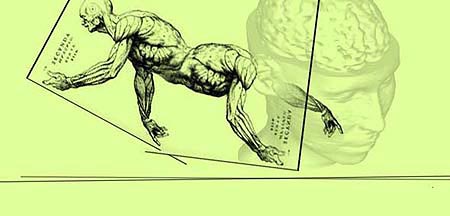 Image from Bernd Helfert |
Sensory Mods
Fairly standard across neb groups are improvements and additions to the human senses. These modifications supplement a nebs greater ability to influence and experience the world.Acute daytime eyesight: Greater density of cones in the retina, a larger fovea and marginally more sophisticated visual processing grant nebs much better visual resolution.
Improved colour vision: Some neb clades have introduced new rod types to make tetrachromacy standard in their populations. Near-infrared and UV are also common, though true thermal vision is rare as a clade standard.
Improved night vision: This goes with slightly larger eyes (see cosmetic changes) and might in more extreme versions require a cat-like vertical pupil, though the latter is likely to be a local or subclade adaptation. In some populations a reflective surface on the back of the retina (a tapetum) also enhances night vision. This causes eyes to appear to "glow" in dim light like those of nocturnal mammals (the selection of a particular colour such as amber, green or red is a cosmetic choice). Higher density of rods combined with some adjustments to the movement of rods and cones in the retina allow improved night vision that does not affect the appearance of the eyes.
Enhanced sense of smell: Many of these modifications have been the result of simple repair of the existing genes for chemical detection, especially those of the vomeronasal organ (which are nonfunctional in human baselines and related baseline primates). Even in an artificial environment those with fully functional chemical senses have an advantage in that they can pick up subtle social cues via pheromones. The ability to detect some industrial toxins by smell is a common addition; it enhances survival in artificial habitats by allowing its bearers to detect unsafe air without mechanical assistance.
Increased acuity and frequency range of hearing: Enhanced acuity is a common side effect of adaptations to hab life in microgravity, since for reasons of economy such environments may be kept at less than one bar of atmospheric pressure, and sounds in thinner air do not propagate as easily.
Magnetosense: A magnetic sense, comparable to that found in some other baseline vertebrate species. This is useful where planets or habs have associated magnetic fields, since it enhances the sense of direction. In some cases it also allows the bearer to detect "live" electrical wires.
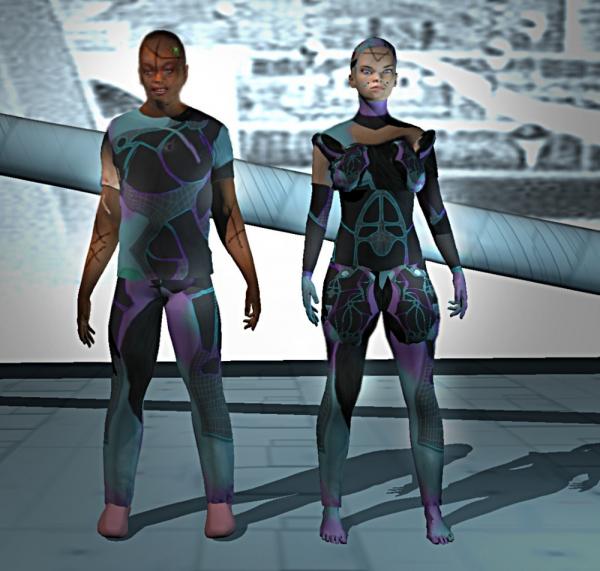 Image from Steve Bowers |
Cosmetic Mods
The most diverse set of genemods in the nearbaseline superclade, altered on the whim of changing fashions and cultural aesthetics. Only the most general mods are listed. Changes to innate baseline preferences have also been possible, but these have usually been part of the creation of entirely new clades (such as the Alchemists). Most cosmetic mods are for traits that the baseline human population, or at least a subset of it, would find attractive.Increased symmetry: A reliable attractor in all biological species from beetles to brontosaurs, possibly because it indicates good developmental health. Nearbaselines are on the average more symmetrical, partly because of course they have that same good developmental health and partly because of specific genes for enhanced symmetry.
Supernormal features: Most bionts find certain key features attractive if they are exaggerated slightly beyond the population's norm (thus "supernormal stimulus," a term from early animal behaviour studies). An exaggeration of traits that are generally considered to be attractive is seen frequently in art across many cultural and historic time periods. Often these artistic representations are at the edge of or slighty beyond the standard range of human appearance. In an individual this can result in an extremely attractive appearance by the standards of the local culture but a consequence is that the offspring of two or more parents can inherit conflicting modifications leading to features that would be deemed ugly or unsettling. As with many modifications consultation with expert software is advised when wishing to procreate.
Altered sexual dimorphism: A subcategory of supernormal features; in many nearbaseline populations natural human sexual dimorphism is increased or decreased according to local culture. Societies that boost dimorphism feature exaggerated secondary sexual characteristics: large breasts and hips, greater than average penis size and hair growth, significant disparity in height between sexes etc. Other societies have gone the opposite way, reducing the differences between the sexes and giving rise to a more androgynous population. Others still have altered what features are dimorphic. However unless these changes are slight the population quickly becomes a tweak clade distinct from the nearbaseline family.
Archetypal and novel ethnicities: Fashion has led in the past to individuals or whole populations who show extreme adherence to a racial appearance, real or imaginary. This may be an Old Earth group, a famous population type from later in Terragen history or even an imitation of some group from works of fantastic fiction. Examples include idealized Old Earth Maoris, Kikuyu, Swedes, Han, Vietnamese, Inuit, famous colonial peoples from the Early Federation era and even appearances inspired by other species of the Homo genus. This has tended to promote diversity and preserve physical types that might have vanished by admixture. On the one hand, once established these groups do tend to choose mates of somewhat similar appearance. On the other hand such exotics tend to attract attention and be re-absorbed into the general nearbaseline population over the next few generations. The net result is an increase in diversity between nearbaseline clades. Some individuals and populations with idealized archaic features are a result of "retro abo" movements. Sometimes, of course, the re-combinations of these features produce appearances that would be quite unusual looking by Old Earth standards even if the elements themselves are not particularly remarkable
Perfect pitch and harmonious voice: Most nearbaseline clades feature the capacity for perfect pitch with a correspondingly greater vocal range. In combination with adjustments to the language areas of the brain this allows nebs to change their usual accents and voice with a small amount of practice, allowing them to adjust as local fashion requires.
Healthier skin and aesthetic tones: Ensures that skin is smooth and unblemished with designer colouring and tone. Beauty standards vary among cultures but can include stronger versions of natural variations, from extremely dark brown to nearly transparent, degree of freckling, patterned variations across the body and tints/undertones. In addition there are a range of common non-natural colourings such as blue-grey colours, true white, dusky red, green (often from symbiotic algae), sparkly or iridescent markings, strong Mandrill-like reds and blues, stripes or spots and skin colour that varies via chromatophores.
Neutral/pleasant body odour: Sweat gland modifications encourage healthy body flora and hygiene. Nearbaselines develop body odour issues at much slower rates than baselines. Common extra modifications allow for the synthesis and release of pleasant scents. Popular methods for determining what scents are produced include varying the diet and, for populations with a greater emphasis on smell in social situations, changes in mood.
Healthy hair: Aside from being more resistant to moulting, splitting and other unhealthy states nearbaseline hair types and distribution can be fixed according to local and individual choice. Diversity is high across neb clades from multicoloured fine hair all over the body to a few dozen extremely thick hairs on the crown only.
Related Articles
- Genetics - Text by M. Alan Kazlev
The study of heredity, genes, and the genome, both terragen and alien (this latter is sometimes called xenogenetics). Includes also the mapping of the genotype with the phenotype, simulation of past and future inheritance and evolutionary paths, and the basic theory behind gengineering. - Gengineer, Geneer (profession)
- Genome
- Genotype - Text by M. Alan Kazlev; additions by Stephen Inniss
Hereditary constitution of an individual; its genome (or equivalent, in artificial neumann-capable organisms or in xenobionts). Contrast with phenotype. - Genotypic Augmentation - Text by M. Alan Kazlev
Modification or augmentation that effects only the genotype of the gametes and descendants of an organism. Genotypic augmentation is biological or genetic modification or augmentation that effects only the genotype of the gametes and descendants of an organism. It does not alter the characteristics of the user, or of clones from the user's somatic cells, but it does modify that of all of the user's offspring. Contrast with phenotypic augmentation. - Homo Superior Genemods
- Humans
- Institute for Primate Provolution
- Ireaders
- Retro Abo
- Slearners
- Slinguists
Appears in Topics
Development Notes
Text by Ryan B
from an original article by Stephen Inniss; additional material by Todd Drashner, Radtech497, Steve Bowers
Initially published on 01 January 2009.
Revised 16 November 2017
Additions 9 November 2024
from an original article by Stephen Inniss; additional material by Todd Drashner, Radtech497, Steve Bowers
Initially published on 01 January 2009.
Revised 16 November 2017
Additions 9 November 2024
